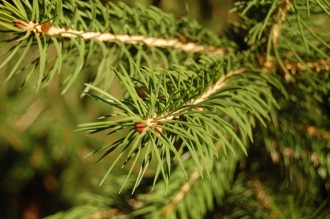Position: Full sun to partial shade
Flowering period: Spring
Soil: Moist, well drained
Eventual Height: 35m
Eventual Spread: 15m
Hardiness: 7b, 8a, 8b, 9a, 9b, 10a, 10b
Family: Pinaceae
Picea chihuahuana is an evergreen tree with a conical crown. Its blue/ green needle like leaves are up to 23mm long and have very sharp tips. Its trunk may achieve a diameter of up to 1m. Its pale grey bark is furrowed, scaly and flakes off in circular plates which are up to 10cm across. Its flowers are in the form of cones. Its fruit are pendulous cones, up to 12cm long and 5cm broad, these are initially green, maturing to orange/ brown.
Picea chihuahuana, commonly known as Chihuahua Spruce or Cahuite, is native to north west Mexico. Picea chihuahuana is classified as ‘Endangered’ according to the IUCN List of Threatened Species. It was discovered by a Mexican botanist named Maximino Martínez in 1942.
The etymological root of the binomial name Picea is derived from the Lain Pix meaning ‘pitch’ or ‘tar’ in reference to the Spruce tree’s resin. Chihuahuana is named after the mountains from where this species is native.
The landscape architect may find Picea chihuahuana useful as a specimen Spruce tree in warmer climates, as this tree is one of the most heat tolerant Spruces.
Ecologically, Picea chihuahuana cones are attractive to some birds and mammals.
Picea chihuahuana prefers moist, fertile, well-drained soils. It prefers an acid to neutral pH of soil.
Picea chihuahuana requires little maintenance.






Leave a comment